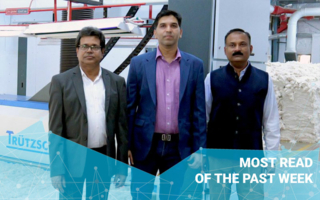
Dr. Lajos Szabó, Leiter der Forschungsgruppe Polytronic, repräsentierte das TITK und seine Neuheiten auf der iENA 2024 in Nürnberg. © privat

Dr. Lajos Szabó, Leiter der Forschungsgruppe Polytronic, repräsentierte das TITK und seine Neuheiten auf der iENA 2024 in Nürnberg. © privat

Das Technikum Laubholz unterstreicht mit der Eröffnung der Pilotanlage seine Position als Vorreiter in der Translation von nachhaltigen Technologien in den Markt. © Technikum Laubholz GmbH

Doktorand Alexander Jäckel untersucht im Labor mit Terahertz-Wellen, die Struktur und die elektrischen Eigenschaften von dünnen leitfähigen Schichten auf Textilien. © Philipps-Universität Marburg

Uzbekistan was chosen as the host of this year’s convention due to its rapidly growing role in the global textile and apparel industries. © ITMF

From left to right: Gautam Kumar Dhang (CEO Fabric Business Gimatex), Vineet Mohota (Director Gimatex) and Manish Deolankar (General Manager Gimatex) in front of Trützschler’s Bale Opener. © Trützschler Group SE